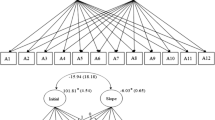Abstract
The present study compares core beliefs between a group of patients with social phobia (n = 62), other anxiety disorders (n = 41) and a group of non-psychiatric controls (n = 55). Participants completed measures to assess social anxiety and the Young’s Schema Questionnaire (123-items version) that is designed to assess 15 early maladaptive schemas (EMSs). Results suggest that the schematic structure of patients with social phobia differs from the one of patients with other anxiety disorders and from normal controls’. Patients with social phobia show higher levels of EMSs particularly in the area of disconnection/rejection than patients with other anxiety disorders. Regression analysis identified the EMSs of mistrust/abuse, social undesirability/defectiveness, entitlement, emotional deprivation, unrelenting standards and shame, as the ones that explain most of the variance in our sample subject’s anxiety that they felt in social situations and on fear of negative evaluation.
Similar content being viewed by others
References
American Psychiatric Association (1994). Diagnostic and statistical manual of mental disorders: DSM-IV (4th ed.). Washington, DC: American Psychiatric Association.
Beck, A. T., Emery, G., & Greenberg, R. L. (1985). Anxiety disorders and phobias: A cognitive perspective. New York: Basic Books.
Clark, D. M., & Wells, A. (1995). A cognitive model of social phobia. In R. Heimberg, M. Liebowitz, D. A. Hope, & F. R. Schneier (Eds.), Social phobia: Diagnosis, assessment and treatment. New York: Guilford.
Coupland, N. J. (2001). Social phobia: Aetiology, neurobiology, and treatment. The Journal of Clinical Psychiatry, 62(Suppl 1), 25–35.
Gelernter, C. S., Stein, M. B., Tancer, M. E., & Uhde, T. W. (1992). An examination of syndromal validity and diagnostic subtypes in social phobia and panic disorder. The Journal of Clinical Psychiatry, 53(1), 23–27.
Herbert, J. D., Hope, D. A., & Bellack, A. S. (1992). Validity of the distinction between generalized social phobia and avoidant personality disorder. Journal of Abnormal Psychology, 101(2), 332–339.
Hudson, J. L., & Rapee, R. M. (2000). The origins of social phobia. Behaviour Modification, 24(1), 102–129.
Marteinsdottir, I., Furmark, T., Tillfors, M., Fredrikson, M., & Ekselius, L. (2001). Personality traits in social phobia. European Psychiatry, 16(3), 143–150.
Mattick, R., & Clarke, J. (1998). Development and validation of measures of social phobia scrutiny fear and social interaction anxiety. Behaviour Research and Therapy, 36, 455–470.
Neal, J. A., & Edelmann, R. J. (2003). The etiology of social phobia: Toward a developmental profile. Clinical Psychology Review, 23(6), 761–786.
Nordahl, H. M., & Nysaeter, T. E. (2005). Schema therapy for patients with borderline personality disorder: A single case series. Journal of Behavior Therapy and Experimental Psychiatry, 36(3), 254–264.
Pinto-Gouveia, J., Robalo, M., Cunha, M., & Fonseca, L. (1997). O questionário de esquemas de Young: aferição e utilização na população portuguesa [Young´s Schema Questionnaire: translation and adaptation to the Portuguese population]. Paper presented at the V Latini Dies, Cascais, Portugal.
Pinto-Gouveia, J., Cunha, M. I., & Salvador, M. C. (2003). Assessment of social phobia by self-report questionnaires: The social interaction and performance anxiety and avoidance scale and the social phobia safety behaviour scale. Behavioural and Cognitive Psychotherapy, 31, 291–311.
Pinto-Gouveia, J., Fonseca, L., Robalo, M., Allen, A., Matos, A. P., & Gil, E. (1986). Ansiedade social: Utilização dos questionários de auto-resposta SAD, FNE e SISST numa população portuguesa [Social anxiety: The utilization of SAD, FNE and SISST in a Portuguese population]. Psiquiatria Clínica, 7, 43–48.
Pinto-Gouveia, J., & Salvador, M. C. (2001). The social interaction anxiety scale and the social phobia scale in the Portuguese population. Paper presented at the XXXI Annual Congress of European Association For Behavioural and Cognitive Therapies, Istambul – Turkey.
Rapee, R. M., & Heimberg, R. G. (1997). A cognitive-behavioral model of anxiety in social phobia. Behaviour Research and Therapy, 35, 741–756.
Rapee, R. M., & Spence, S. H. (2004). The aetiology of social phobia: Empirical evidence and an initial model. Clinical Psychology Review, 24(7), 737–767.
Schmidt, N. B., Joiner, T. E., Young, J. E., & Telch, M. J. (1995). The schema questionnaire: Investigation of psychometric properties and the hierarchical structure of a measure of maladaptive schemas. Cognitive Therapy and Research, 19, 295–321.
Shah, R., & Waller, G. (2000). Parental style and vulnerability to depression: The role of core beliefs. The Journal of Nervous and Mental Disease, 188(1), 19–25.
Watson, D., & Friend, R. (1969). Measurement of social-evaluative anxiety. Journal of Consulting and Clinical Psychology, 33, 448–457.
Welburn, K., Coristine, M., Dagg, P., Pontefract, A., & Jordan, S. (2002). The schema questionnaire-short form: Factor analysis and relationship between schemas and symptoms. Cognitive Therapy and Research, 26, 519–530.
Williams, J. M., Watts, F. N., Macleod, C., & Mathews, A. (1997). Cognitive psychology and emotional disorders. (2nd ed.). Chichester: Wiley.
Young, J. (1990). Cognitive therapy for personality disorders: A schema-focused approach. Sarasota, FL: Professional Resource Exchange.
Young, J. (1999). Cognitive therapy for personality disorders: A schema-focused approach (3rd ed.). Sarasota, FL: Professional Resource Exchange.
Young, J., & Brown, G. (1989). Schema questionnaire. Unpublished manuscript. Cognitive Therapy Centre of New York.
Young, J. E., Klosko, J. S., & Weishaar, M. E. (2003). Schema therapy: A practitioner’s guide. New York: The Guilford Press.
Acknowledgments
This study was supported in part by the CINEICC financed by the FCT. The authors wish to acknowledge the helpful comments and suggestions of the anonymous reviewers on earlier version of this manuscript.
Author information
Authors and Affiliations
Corresponding author
Rights and permissions
About this article
Cite this article
Pinto-Gouveia, J., Castilho, P., Galhardo, A. et al. Early Maladaptive Schemas and Social Phobia. Cogn Ther Res 30, 571–584 (2006). https://doi.org/10.1007/s10608-006-9027-8
Published:
Issue Date:
DOI: https://doi.org/10.1007/s10608-006-9027-8




